new posts in all blogs
Viewing: Blog Posts Tagged with: middle grade nonfiction, Most Recent at Top [Help]
Results 1 - 18 of 18
How to use this Page
You are viewing the most recent posts tagged with the words: middle grade nonfiction in the JacketFlap blog reader. What is a tag? Think of a tag as a keyword or category label. Tags can both help you find posts on JacketFlap.com as well as provide an easy way for you to "remember" and classify posts for later recall. Try adding a tag yourself by clicking "Add a tag" below a post's header. Scroll down through the list of Recent Posts in the left column and click on a post title that sounds interesting. You can view all posts from a specific blog by clicking the Blog name in the right column, or you can click a 'More Posts from this Blog' link in any individual post.
 I peer into the darkness and at long last I see the light at the end of the tunnel. We’re almost there! Almost at the end of this month’s 31 Days, 31 Lists challenge. I’m certainly delighted, not least because I’ve managed to keep it up so far (knocking on wood now as hard as my brittle knuckles can knock).
I peer into the darkness and at long last I see the light at the end of the tunnel. We’re almost there! Almost at the end of this month’s 31 Days, 31 Lists challenge. I’m certainly delighted, not least because I’ve managed to keep it up so far (knocking on wood now as hard as my brittle knuckles can knock).
As with some of the lists, today’s is not by any means complete. I fell down on the job of reading as many chapter nonfiction books as I should have. And since I refuse to place any books on these lists that I haven’t actually read myself, it’s going to be far too short. For a variety of far more complete lists featuring nonfiction, please check out the Best of the Year compilations from all the major review journals (SLJ, Kirkus, Horn Book, etc.) as well as libraries like NYPL, Chicago Public Library, and others.
2016 Great Nonfiction Chapter Books for Kids
A Celebration of Beatrix Potter: Art and Letters by More Than 30 of Today’s Favorite Children’s Book Illustrators, edited by The Stewards of Frederick Warne & Co.
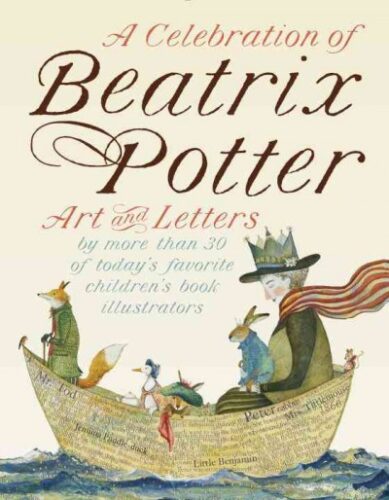
It seems a pity that I’m only just now mentioning this book, but I honestly couldn’t figure out if there was any other list it would slot into easily. In truth, it’s probably made for adult enthusiasts and not actual kids, but who knows? There could be some Potter loving children out there. Maybe they’d be interested in the wide variety of takes on one classic Potter character or another. Whatever the case, this book is a beautiful ode to the works of Beatrix and anyone would be pleased to receive it.
Crow Smarts: Inside the Brain of the World’s Brightest Bird by Pamela S. Turner, photos by Andy Comins, ill. Guido de Flilippo

This is right up there with Sy Montgomery’s Kakapo book as one of my favorite books about obscure birds out there. Of course, the Kakapo is dumb as a box of rocks while these birds are smarter than human 4-year-olds, but who’s counting?
Deep Roots: How Trees Sustain Our Planet by Nikki Tate

Orca consistently produces fun nonfiction titles on serious subjects in a voice that never patronizes its young readers. This latest is no exception.
The Hello Atlas by Ben Handicott, ill. Kenard Pak
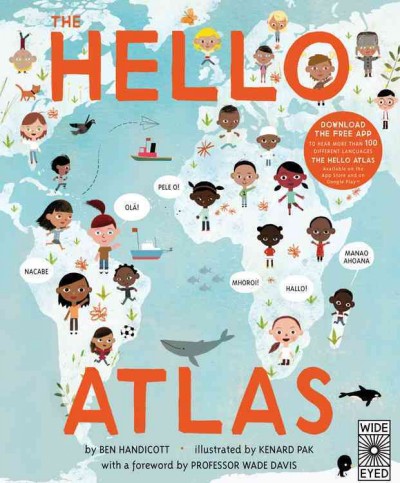
I really wasn’t sure where to put this one either, and it just feels like it has a bit too much content to consider it a picture book. The publisher calls this, “A celebration of humanity’s written and verbal languages is comprised of fully illustrated word charts depicting children of diverse cultures participating in everyday activities, in a reference complemented by a free downloadable app for iOS and Android that allows readers to hear the book’s phrases as recorded by native speakers”. Cool, right? Well, says Kirkus, “This will be a necessity for just about everybody, as there are no phonetic spellings”. So word to the wise. It’s still a pretty amazing book.
Presenting Buffalo Bill: The Man Who Invented the Wild West by Candace Fleming
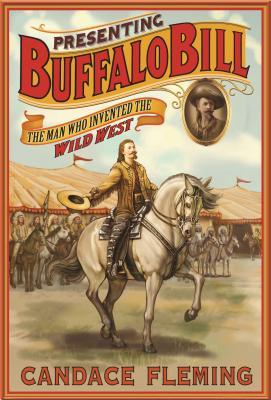
Did I mention I liked it yet?
I liked it.
Sachiko: A Nagasaki Bomb Survivor’s Story by Caren Stelson
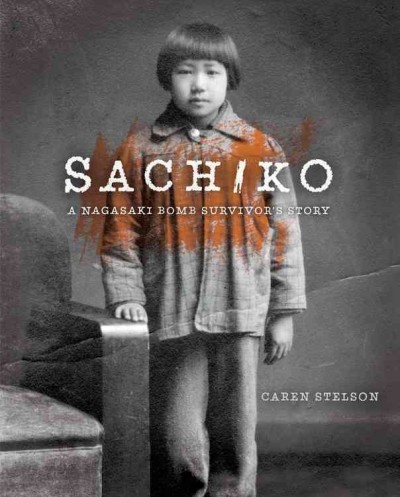
Still one of the most powerful books of the year.
Samurai Rising: The Epic Life of Minamoto Yoshitsune by Pamela S. Turner, ill. Gareth Hinds
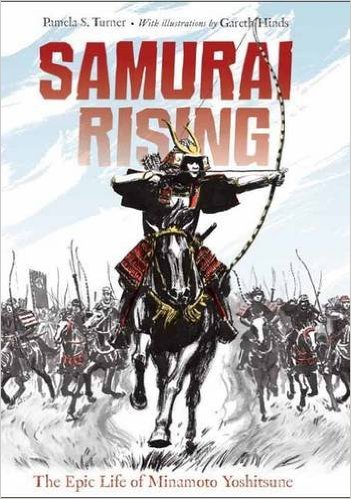
This one came out so early in the year that I almost forgot it was a 2016 title. Then I remembered that there’s this crazy outside chance that it could win a Newbery for its fantastic writing. So there’s that.
Some Writer! The Story of E.B. White by Melissa Sweet
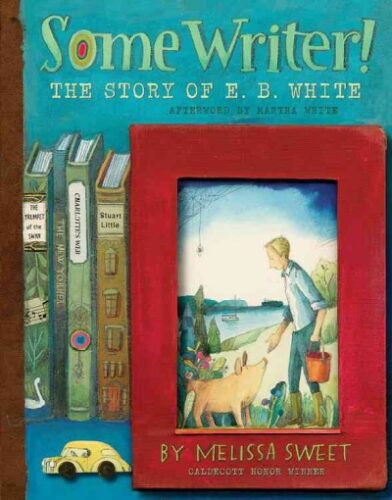
It took me a while to jump on the bandwagon with this one, since I’m sometimes slow on the uptake. Now that I’ve read it, I’m gratified to write that it really is quite amazing. I’m not sure what kid would pick it up on their own, but it does a really lovely job of encapsulating White’s life and spends a good amount of time on his writing for children. Visually arresting from start to finish, this is one of the best bios of the year. Glad I followed the crowd on this one.
What Milly Did by Elise Moser, ill. Scot Ritchie
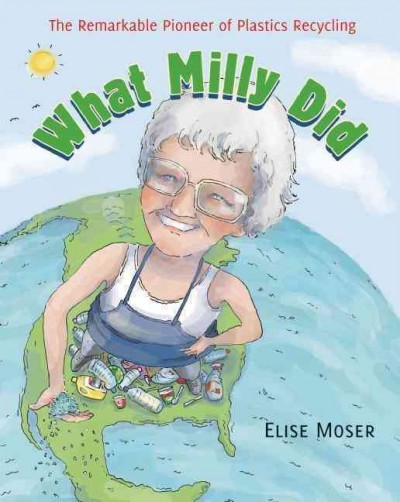
I’m not a huge fan of the cover, but I think the book’s worth its weight in gold. FYI.
Interested in the other lists of the month? Here’s the schedule so that you can keep checking back:
December 1 – Board Books
December 2 – Board Book Adaptations
December 3 – Nursery Rhymes
December 4 – Picture Book Readalouds
December 5 – Rhyming Picture Books
December 6 – Alphabet Books
December 7 – Funny Picture Books
December 8 – Calde-Nots
December 9 – Picture Book Reprints
December 10 – Math Picture Books
December 11 – Bilingual Books
December 12 – International Imports
December 13 – Books with a Message
December 14 – Fabulous Photography
December 15 – Fairy Tales / Folktales
December 16 – Oddest Books of the Year
December 17 – Older Picture Books
December 18 – Easy Books
December 19 – Early Chapter Books
December 20 – Graphic Novels
December 21 – Poetry
December 22 – Fictionalized Nonfiction
December 23 – American History
December 24 – Science & Nature Books
December 25 – Transcendent Holiday Titles
December 26 – Unique Biographies
December 27 – Nonfiction Picture Books
December 28 – Nonfiction Chapter Books
December 29 – Novel Reprints
December 30 – Novels
December 31 – Picture Books

 There were no science books on the YALSA Award for Excellence in Nonfiction for 2016. Nor in 2015. Nor 2014. Bomb in 2013 was sort of a science book, so we’ll count that. And Moonbird that year certainly was. Yet it’s often surprising how consistently science and nature get overlooked when they’re handing out awards for nonfiction. According to my sources, science writers are complaining about this fact, and with good reason. When you create an award for nonfiction and then hand it consistently to biographies, you are, however unintentionally, sending a message.
There were no science books on the YALSA Award for Excellence in Nonfiction for 2016. Nor in 2015. Nor 2014. Bomb in 2013 was sort of a science book, so we’ll count that. And Moonbird that year certainly was. Yet it’s often surprising how consistently science and nature get overlooked when they’re handing out awards for nonfiction. According to my sources, science writers are complaining about this fact, and with good reason. When you create an award for nonfiction and then hand it consistently to biographies, you are, however unintentionally, sending a message.
On the children’s side of things the Robert F. Sibert Medal fares a bit better. In 2016 none of the books were science or nature related, but in 2015 we had Neighborhood Sharks and in 2014 Parrots Over Puerto Rico by Susan L. Roth and Cindy Trumbore actually took home the Medal itself with Look Up! Bird-Watching in Your Own Backyard by Annette LeBlanc Cate getting an Honor. You go, Sibert committees!
In their honor, I dedicate today’s list to the lovely science and nonfiction books that were published in 2016 with a hat tip to Melissa Stewart for inspiring me to do this list in the first place.
2016 Science and Nature Books for Kids
FICTION PICTURE BOOKS
Honoring those books willing to add a little science and nature in their mix. Extra points for backmatter.
Ada Twist: Scientist by Andrea Beaty
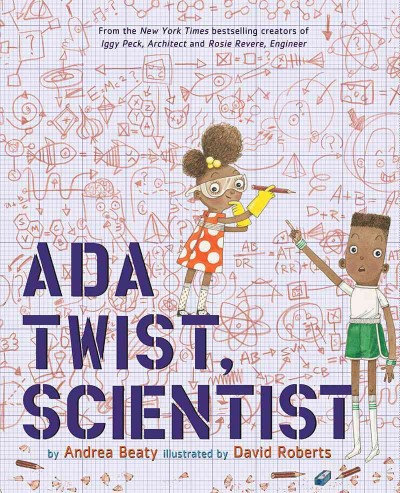
Unless I’m much mistaken, she’s still topping the New York Times bestseller list in the picture book category. I’ll give you some moments to take in the vast implications of this. Pairs particularly well with the upcoming film Hidden Figures.
Baby Loves: Aerospace Engineering!/Quarks! by Ruth Spiro, ill. Irene Chan

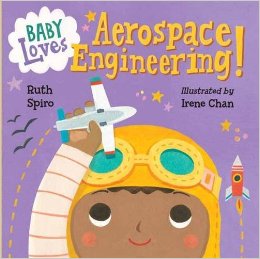
I defended this to you when I put it on the board book list, and I’d willingly do so now. Don’t just assume that due to their format these are meant solely for babies. It’s a kitchy idea that yields a lot of plum rewards. Big concepts are broken down for young people. I can get behind that.
Because of an Acorn by Lola M. Schaefer & Adam Schaefer, ill. Frann Preston-Gannon

It’s the ciiiiiiircle of liiiiiife . . . and it mooooooves us alllllllll . . .
Coyote Moon by Maria Gianferrari, ill. Bagram Ibatoulline

Apparently coyotes roam my own neighborhood’s streets in the summer. I’ve never seen them, but I’m willing to believe it. Jaw-droppingly gorgeous with a surprisingly gripping text, this is sort of like a more fictionalized version of the aforementioned Neighborhood Sharks, only this time with coyotes. In hindsight, I should have put this on the readaloud list too. GREAT readalouding.
Faraway Fox by Jolene Thompson, ill. Justin K. Thompson

The book follows a single fox blocked off from its fellows by a highway. Humans construct a tunnel under the road for wildlife and the fox is reunited with its kind. Information appears at the end about the real world tunnels, how they are constructed, and some of the challenges they fact. The art, for the record, is also a real draw here. Luscious.
Follow the Moon Home: A Tale of One Idea, Twenty Kids, and a Hundred Sea Turtles by Philippe Cousteau & Deborah Hopkinson, ill. Meilo So
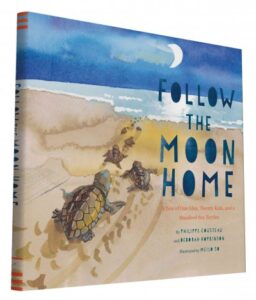
The only Meilo So book out this year? Nope, there’s one coming up later (see if you can guess what it is). Here, a girl attempts to save loggerhead sea turtle babies from man-made light, which means she has to engage in some pretty serious activism. A very cool story, and one I’ve not seen told before.
From Wolf to Woof!: The Story of Dogs by Hudson Talbott

This pairs particularly well with . . .
Grandmother Fish: A Child’s First Book of Evolution by Jonathan Tweet, ill. Karen Lewis

. . . this book. Both cover evolution to a certain extent. This scrappy little Kickstarter title covers ground that few books have on evolution.
Mad Scientist Academy: The Weather Disaster by Matthew McElligott
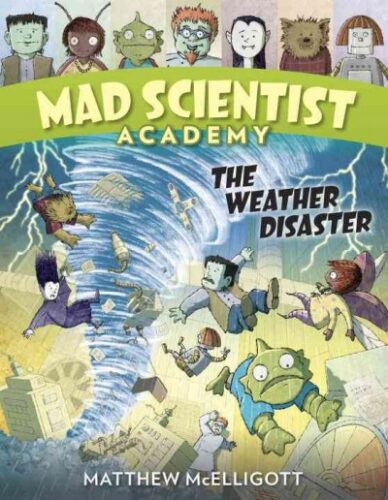
Not a lot of good weather books out this year. This one’s filling a 2016 gap.
Octopus Escapes Again by Laurie Ellen Angus

I’m oddly partial to this adorable book and the creature behind it. Always makes me think of this stranger still video, of course.
Olinguito, from A to Z! / Olinguito, de la A a la Z! by Lulu Delacre
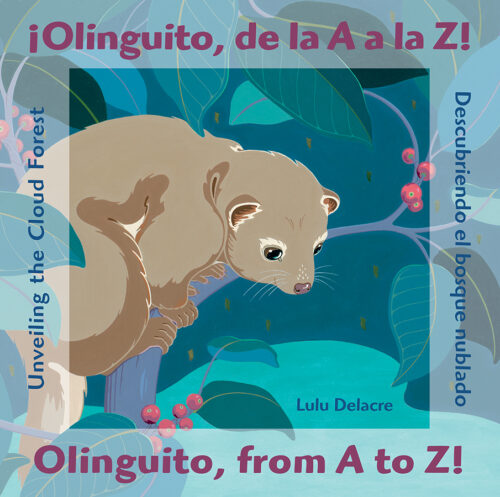
Sure, it’s an alphabet book. Sure it’s bilingual. But it’s actually a really delightful trip into the cloud forest to talk about “discovering” a new animal. Drills home to kids the fact that this is still being done today, barring the destruction of said cloud forest.
Otters Love to Play by Jonathan London, ill. Meilo So

It’s the second Meilo So title on this list today! Hooray! And otters basically just sell themselves. In writing this part of today’s list I just wasted a lot of time watching otters on YouTube for inspiration (have you seen the one of the baby sleeping on its mommy?). In any case, this lives up to its subject matter.
NONFICTION CHILDREN’S BOOKS
Animals by the Numbers: A Book of Infographics by Steve Jenkins

I just recommended this book to a colleague looking for a book to give to a 7-year-old who loves facts and figures and animals too. Couldn’t have come up with anything better! Plus, it’s where I learned that the peregrine falcons that nest on my library every year are the fastest birds in the world.
A Beetle Is Shy by Dianna Hutts Aston, ill. Sylvia Long
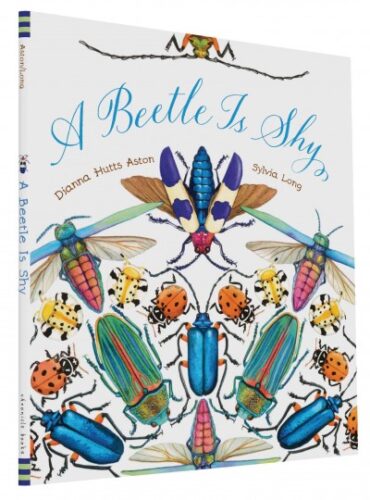
This is a long-standing series but it doesn’t appear to be slowing down in any way, shape, or form. Distinctly fabulous.
The Deadliest Creature in the World by Brena Z. Guiberson, ill. Gennady Spirin
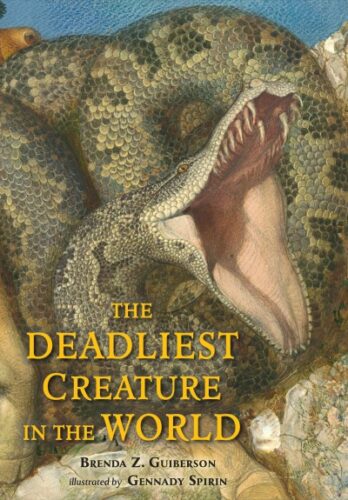
I’m a sucker for a Guiberson/Spirin combo any day of the week. Actually, I’m a sucker for Spirin, period, but his work with Guiberson over the years has never produced a melon. Plus, how do you top that title? Answer: You don’t.
Deep Roots: How Trees Sustain Our Planet by Nikki Tate

I was blown away with this book. Seriously floored. You go into it thinking it’s just another gee-aren’t-trees-great title and what you get instead is this enormously in-depth, serious consideration of how they contribute to the earth. We’ve all heard the statistics on how much oxygen in the atmosphere they produce, but this was the first children’s book I’ve ever read that attempted to explain precisely how their root system works. I’d listened to a RadioLab episode (From Tree to Shining Tree) that explained this and I’m still shocked by the implications. Well done Ms. Tate for filling this book with such pertinent, incredibly up-to-date information!
Dining With Dinosaurs: A Tasty Guide to Mesozoic Munching by Hannah Bonner
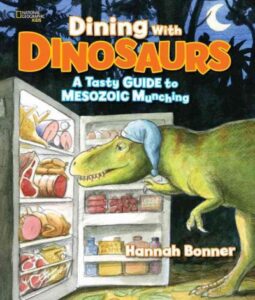
I’m not just sticking this on here because I need a dino title. Trust me, my library shelves are good in that area. But this took a distinctly deep and delightful look at a topic I would have told you had already been covered. Turns out, not so much. A must-add.
Does a Fiddler Crab Fiddle? by Corinne Demas & Artemis Roehrig, ill. John Sandford
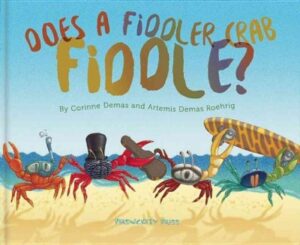
I honestly thought the book was just going to start with fiddler crab and then move on to other animals with evocative names. Nope. Demas and Roehrig are in it for the long haul. The long fiddler crab haul. Good on them!
Feathered Dinosaurs by Brenda Z. Guiberson, ill. William Low
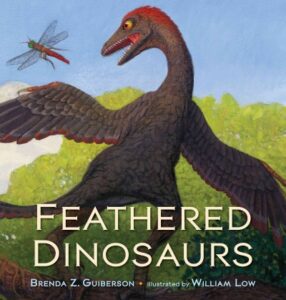
Because you can’t have enough dinosaurs. Or enough Guiberson, for that matter.
Flying Frogs and Walking Fish: Leaping Lemurs, Tumbling Toads, Jet-Propelled Jellyfish, and More Surprising Ways That Animals Move by Steve Jenkins and Robin Page
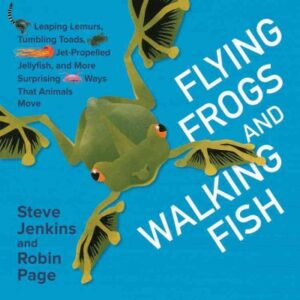
I’d cut that title way way down, but that’s the only thing I’d cut from this highly engaging title (plus it’s always great to see Jenkins and Page working together again).
How Much Does a Ladybug Weigh? by Alison Limentani
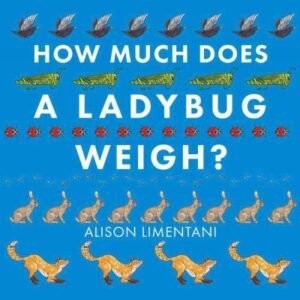
I put this on the math list not too long ago, but it’s also a really interesting, very young, science title. When you consider how much each animal weighs, you find yourself having your assumptions consistently challenged. Math and science = best buds.
I Am NOT a Dinosaur by Will Lach, ill. Jonny Lambert

My college, for whatever reason, owned the skeleton of a giant sloth. I remember seeing it for the first time on display, just utterly baffled by what I was looking at. Sloths were giants once? If you’ve a kid, hand them this book and they’ll be able to know this information far sooner than my sad college-aged self.
If You Are a Kaka, You Eat Doo Doo: And Other Poop Tales from Nature by Sara Martel, ill. Sara Lynn Cramb
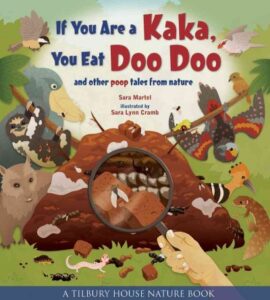
That title’s gonna turn off a bunch of folks right from the start. Maybe that’s not the worst thing, since it really is a book entirely about poop. That said, it’s not gross about it. I mean, there are gross things in it (one word: smearing) but they’re presented in a very matter-of-fact way. If you buy only one poop book this year . . .
My Book of Birds by Geraldo Valerio
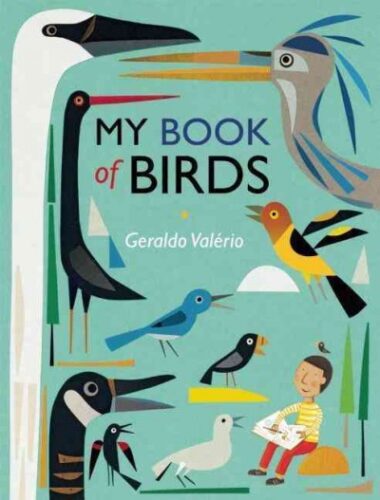
Shockingly lovely from start to finish. A science picture book coffee table book, if you take my meaning.
Natumi Takes the Lead: The True Story of an Orphan Elephant Who Finds Family by Gerry Ellis with Amy Novesky
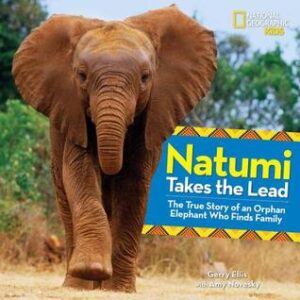
Such a good story, and a good readaloud too. I’d normally avoid any book that traipses this close to anthropomorphism but Gerry and Amy are very careful to place everything in terms true to a baby elephant. Could actually work as a graduation gift picture book as well, come to think of it.
Pink Is for Blobfish: Discovering the World’s Perfectly Pink Animals by Jess Keating, ill. David DeGrand
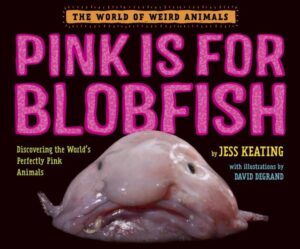
Not solely about the blobfish, alas, but still worth your time thanks to the sheer number of facts packed into these pages.
Plants Can’t Sit Still by Rebecca E. Hirsch, ill. Mia Posada

A cute premise. Shows all the different ways that plants get up and go go go!
The Polar Bear by Jenni Desmond

Though it’s not sourced properly (no backmatter to speak of) this is still a truly gorgeous book. It’s the kind of title you can use to either sate the polar bear needs of a true fans, or lure other readers into adoring.
Prairie Dog Song: The Key to Saving North America’s Grasslands by Susan L. Roth and Cindy Trumbore

The prairie, its life, its history, and its possible future are all discussed in this beautifully rendered little book.
The Toad by Elise Gravel
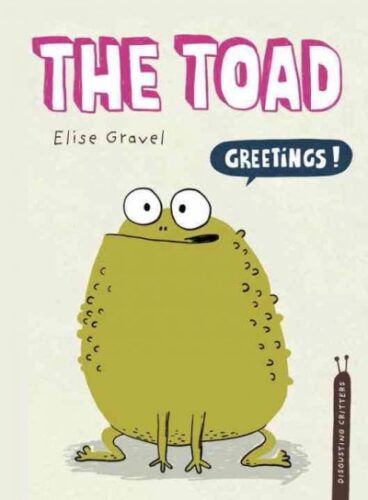
I’m a big fan of all the Gravel series titles. Of the titles out this year, the toad stole my heart. Maybe because I used to catch them in my backyard as a kid. Maybe just because this book’s the funniest.
The Tragic Tale of the Great Auk by Jan Thornhill

I’m a little ashamed to admit that I had no idea what a Great Auk even was before I read this book. Or, for that matter, that they were gone. Sometimes it feels like the passenger pigeon and the dodo get all the press. Poor auks.
Under Earth / Under Water by Aleksandra Mizielinska and Daniel Mizielinski
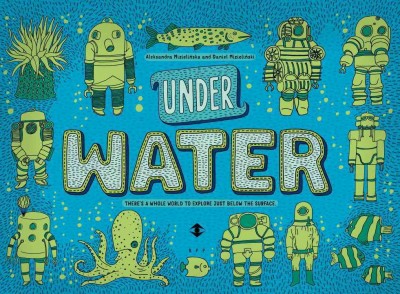
Leave it to the Polish to do something this cool. My kids just dive into this book (no pun intended) since there are so many tiny elements to adore. Again, no backmatter to speak of (European nonfiction titles have that in common) but still awesome. And huge!
What Milly Did: The Remarkable Pioneer of Plastics Recycling by Elise Moser, ill. Scot Ritchie
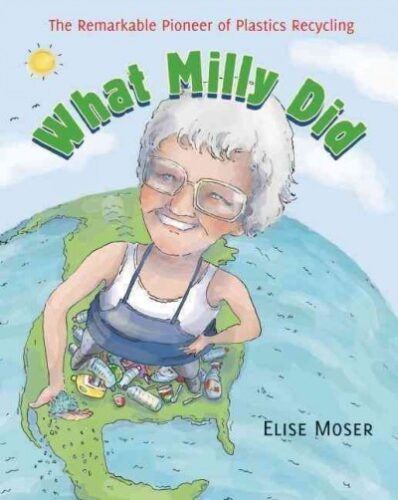
Ever stop to consider the fact that recycling plastics is a relatively new idea? How did it get officially started by vast numbers of cities around the country? A little old woman figured it all out. I love unexpected heroines.
Whoosh! Lonnie Johnson’s Super-Soaking Stream of Inventions by Chris Barton, ill. Don Tate
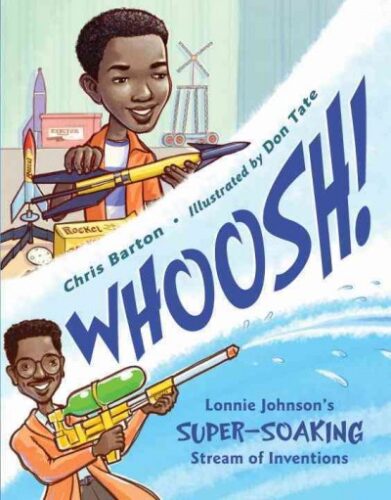
I’m keen on unexpected heroes too. This book is great because it shows that you don’t have to come up with polio vaccine to be considered an inventor. Plus this guy (A) made something cool and (B) is still alive! Once in a while you get a kid in your library who has to check out a bio on someone still alive. Now you’ve an ace in your back pocket.
Whose Eye Am I? by Shelley Rotner

Look them in the eye and tell them you’re not interested in this book. Go on. Tell them.
Interested in the other lists of the month? Here’s the schedule so that you can keep checking back:
December 1 – Board Books
December 2 – Board Book Adaptations
December 3 – Nursery Rhymes
December 4 – Picture Book Readalouds
December 5 – Rhyming Picture Books
December 6 – Alphabet Books
December 7 – Funny Picture Books
December 8 – Calde-Nots
December 9 – Picture Book Reprints
December 10 – Math Picture Books
December 11 – Bilingual Books
December 12 – International Imports
December 13 – Books with a Message
December 14 – Fabulous Photography
December 15 – Fairy Tales / Folktales
December 16 – Oddest Books of the Year
December 17 – Older Picture Books
December 18 – Easy Books
December 19 – Early Chapter Books
December 20 – Graphic Novels
December 21 – Poetry
December 22 – Fictionalized Nonfiction
December 23 – American History
December 24 – Science & Nature Books
December 25 – Transcendent Holiday Titles
December 26 – Unique Biographies
December 27 – Nonfiction Picture Books
December 28 – Nonfiction Chapter Books
December 29 – Novel Reprints
December 30 – Novels
December 31 – Picture Books


By:
Betsy Bird,
on 9/11/2016
Blog:
A Fuse #8 Production
(
Login to Add to MyJacketFlap)
JacketFlap tags:
2016 biographies,
Reviews,
biographies,
Roaring Brook,
Best Books,
middle grade nonfiction,
Candace Fleming,
macmillan,
Neal Porter Books,
middle grade biographies,
Best Books of 2016,
2016 reviews,
Reviews 2016,
2016 middle grade nonfiction,
Add a tag
 Presenting Buffalo Bill: The Man Who Invented the Wild West
Presenting Buffalo Bill: The Man Who Invented the Wild West
By Candace Fleming
A Neal Porter Book, Roaring Book Press (a division of Macmillan)
$19.99
ISBN: 9781596437630
Ages 9-12
On shelves September 20th
I’ve been thinking a lot lately about how we present history to our kids. Specifically I was thinking about picture book biographies and whether or not they’re capable of offering a nuanced perspective on a person’s complicated life. Will we ever see an honest picture book biography of Nixon, for example? In talking with a nonfiction author for children the other day, she asked me about middle grade books (books written for 9-12 year olds) and whether or not they are ever capable of featuring complicated subjects. I responded that often they’re capable of showing all kinds of sides to a person. Consider Laura Amy Schlitz’s delightful The Hero Schliemann or Candace Fleming’s The Great and Only Barnum. Great books about so-so people. And Candace Fleming… now there’s an author clearly drawn to historical characters with slippery slidey morals. Her latest book, Presenting Buffalo Bill is a splendid example of precisely that. Not quite a shyster, but by no means possessing a soul as pure as unblemished snow, had you asked me, prior to my reading this book, whether or not it was even possible to write a biography for children about him my answer would have been an unqualified nope. Somehow, Ms. Fleming has managed it. As tangled and thorny a life as ever you read, Fleming deftly shows how perceptions of the American West that persist to this day can all be traced to Buffalo Bill Cody. For good or for ill.
What do you think of when you think of the iconic American West? Cowboys and sage? American Indians and buffalo? Whatever is popping up in your head right now, if it’s a stereotypical scene, you’ve Buffalo Bill Cody to thank for it. An ornery son of a reluctant abolitionist, Bill grew up in a large family in pre-Civil War Kansas. Thanks to his father’s early death, Bill was expected to make money at a pretty young age. Before he knew it, he was trying his luck panning gold, learning the finer points of cowboy basics, and accompanying wagon trains. He served in the Civil War, met the love of his life, and gave tours to rich Easterners looking for adventure. It was in this way that Bill unwittingly found himself the subject of a popular paperback series, and from that he was able to parlay his fame into a stage show. That was just a hop, skip, and a jump to creating his Wild West Show. But was Bill a hero or a shyster? Did he exploit his Indian workers or offer them economic opportunities otherwise unavailable to them? Was he a caring man or a philanderer? The answer: Yes. And along the way he may have influenced how the world saw the United States of America itself.
 So let’s get back to that earlier question of whether or not you can feature a person with questionable ethics in a biography written for children. It really all just boils down to a question of what the point of children’s biographies is in the first place. Are they meant to inspire, or simply inform, or some kind of combination of both? In the case of unreliable Bill, the self-made man (I’m suddenly hearing Jerry Seinfeld’s voice saying to George Costanza, “You’re really made something of yourself”) Candace Fleming had to wade through loads of inaccurate data produced, in many cases, by Bill himself. To combat this problem, Ms. Fleming employs a regular interstitial segment in the book called “Panning for the Truth” in which she tries to pry some grain of truth out of the bombast. If a person loves making up the story of their own life, how do you ever know what the truth is? Yet in many ways, this is the crux of Bill’s story. He was a storyteller, and to prop himself up he had to, in a sense, prop up the country’s belief in its own mythology. As he was an embodiment of that mythology, he had a vested interest in hyping what he believed made the United States unique. Taking that same message to other countries in the world, he propagated a myth that many still believe in today. Therefore the story of Bill isn’t merely the story of one man, but of a way people think about our country. Bill was merely the vessel. The message has outlived him.
So let’s get back to that earlier question of whether or not you can feature a person with questionable ethics in a biography written for children. It really all just boils down to a question of what the point of children’s biographies is in the first place. Are they meant to inspire, or simply inform, or some kind of combination of both? In the case of unreliable Bill, the self-made man (I’m suddenly hearing Jerry Seinfeld’s voice saying to George Costanza, “You’re really made something of yourself”) Candace Fleming had to wade through loads of inaccurate data produced, in many cases, by Bill himself. To combat this problem, Ms. Fleming employs a regular interstitial segment in the book called “Panning for the Truth” in which she tries to pry some grain of truth out of the bombast. If a person loves making up the story of their own life, how do you ever know what the truth is? Yet in many ways, this is the crux of Bill’s story. He was a storyteller, and to prop himself up he had to, in a sense, prop up the country’s belief in its own mythology. As he was an embodiment of that mythology, he had a vested interest in hyping what he believed made the United States unique. Taking that same message to other countries in the world, he propagated a myth that many still believe in today. Therefore the story of Bill isn’t merely the story of one man, but of a way people think about our country. Bill was merely the vessel. The message has outlived him.
I’ve heard folks online say of the book that they can’t imagine the child who’d come in seeking a bio of Buffalo Bill. Since kids don’t like cowboys like they used to, the very existence of this book in the universe puzzles them. Well, putting aside the fact that enjoying a biography often has very little to do with the fact that you already were interested in the subject (or any nonfiction book, for that matter), let’s just pick apart precisely why a kid might get a lot out of reading about Bill. He was, as I have mentioned, a humbug. But he was also for more than that. He was a fascinating mix of good and evil. He took credit for terrible deeds but also participated in charitable acts (whether out of a sense of obligation or mere money is a question in and of itself). He no longer fits the mold of what we consider a hero to be. He also doesn’t fit the mold of a villain. So what does that leave us with? A very interesting human being and those, truth be told, make for the best biographies for kids.
 The fact that Bill is a subject of less than sterling personal qualities is not what makes this book as difficult as it is to write (though it doesn’t help). The real problem with Bill comes right down to his relationships with American Indians. How do we in the 21st century come to terms with Bill’s very white, very 19th century attitudes towards Native Americans? Fleming tackles this head on. First and foremost, she begins the book with “A Note From the Author” where she explains why she would use one term or another to describe the Native Americans in this book, ending with the sentence, “Always my intention when referring to people outside my own cultural heritage is to be respectful and accurate.” Next, she does her research. Primary sources are key, but so is work at the McCracken Research Library at the Buffalo Bill Center of the West in Cody, Wyoming. Her work was then vetted by Dr. Jeffrey Means (Enrolled Member of the Oglala Sioux Tribe), Associate Professor of History at the University of Wyoming in the field of Native American History, amongst others. I was also very taken with the parts of the book that quote Oglala scholar Vine Deloria Jr., explaining at length why Native performers worked for Buffalo Bill and what it meant for their communities.
The fact that Bill is a subject of less than sterling personal qualities is not what makes this book as difficult as it is to write (though it doesn’t help). The real problem with Bill comes right down to his relationships with American Indians. How do we in the 21st century come to terms with Bill’s very white, very 19th century attitudes towards Native Americans? Fleming tackles this head on. First and foremost, she begins the book with “A Note From the Author” where she explains why she would use one term or another to describe the Native Americans in this book, ending with the sentence, “Always my intention when referring to people outside my own cultural heritage is to be respectful and accurate.” Next, she does her research. Primary sources are key, but so is work at the McCracken Research Library at the Buffalo Bill Center of the West in Cody, Wyoming. Her work was then vetted by Dr. Jeffrey Means (Enrolled Member of the Oglala Sioux Tribe), Associate Professor of History at the University of Wyoming in the field of Native American History, amongst others. I was also very taken with the parts of the book that quote Oglala scholar Vine Deloria Jr., explaining at length why Native performers worked for Buffalo Bill and what it meant for their communities.
What surprised me the most about the book was that I walked into it with the pretty clear perception that Bill was a “bad man”. A guy who hires American Indians to continually lose or be exploited as part of some traveling show meant to make white Americans feel superior? Yeah. Not on board with that. But as ever, the truth is far more complicated than that. Fleming delves deep not just into the inherently racist underpinnings of Bill’s life, but also its contradictions. Bill hated Custer when he knew the guy and said publicly that the defeat of Custer was no massacre, yet would reenact it as part of his show, 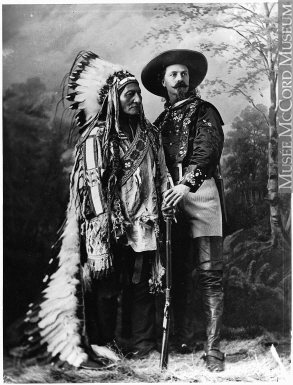 with Custer as the glorified dead hero. He would hire Native performers, pay them a living wage, and speak highly of them, yet at the same time he murdered a young Cheyenne named Yellow Hair and scalped him for his own glory. Fleming is at her best when she recounts the relationship of Bill and Sitting Bull. A photo of the two shows them standing together “as equals . . . but it is obvious that Bill is leading the way while Sitting Bull appears to be giving in. What was the subtext of the photo? That the ‘friendship’ offered in the photograph – and in Wild West performances – honored American Indian dignity only at the expense of surrender to white dominance and control.”
with Custer as the glorified dead hero. He would hire Native performers, pay them a living wage, and speak highly of them, yet at the same time he murdered a young Cheyenne named Yellow Hair and scalped him for his own glory. Fleming is at her best when she recounts the relationship of Bill and Sitting Bull. A photo of the two shows them standing together “as equals . . . but it is obvious that Bill is leading the way while Sitting Bull appears to be giving in. What was the subtext of the photo? That the ‘friendship’ offered in the photograph – and in Wild West performances – honored American Indian dignity only at the expense of surrender to white dominance and control.”
I’m writing this review in the year of 2016 – a year when Donald Trump is running for President of the United States of America. It’s given me a lot of food for thought about American humbuggery. Here in the States, we’ve created a kind of homegrown demagoguery that lauds the successful humbug. P.T. Barnum was a part of that. Huey Long had it down. And Buffalo Bill may have been a different version of these men, but I’d say he belongs to their club. There’s a thin line between “self-made man” and “making stuff up”. Thinner still when the man in question does as much good and as much evil as Buffalo Bill Cody. Fleming walks a tightrope here and I’d say it’s fair to say she doesn’t fall. The sheer difficulty of the subject matter and her aplomb at handling the topic puts her on a higher plane than your average middle grade biography. Will kids seek out Buffalo Bill’s story? I have no idea, but I can guarantee that for those they do they’ll encounter a life and a man that they will never forget.
On shelves September 20th.
Source: Galley sent from publisher for review.
Like This? Then Try:
Professional Reviews:


By:
Betsy Bird,
on 4/19/2016
Blog:
A Fuse #8 Production
(
Login to Add to MyJacketFlap)
JacketFlap tags:
Reviews,
nonfiction,
Gareth Hinds,
Best Books,
Charlesbridge,
middle grade nonfiction,
narrative nonfiction,
Pamela S. Turner,
Best Books of 2016,
2016 reviews,
Reviews 2016,
2016 middle grade nonfiction,
middle school nonfiction,
Add a tag
 Samurai Rising: The Epic Life of Minamoto Yoshitsune
Samurai Rising: The Epic Life of Minamoto Yoshitsune
By Pamela S. Turner
Illustrated by Gareth Hinds
Charlesbridge
$16.95
ISBN: 9781580895842
Ages 10 and up
On shelves now
When you read enough children’s books published in a single year, folks tend to believe that you’ve an ability to spot trends in the general literature. Trend-spotting is easy enough when you’re dealing with picture books (hot in 2016: Bears rampaging through picnics and blobfish!) but books written for older readers are trickier. I think I’ve hit on at least one incredibly popular trend for the current year, however: Overwhelming depression and sadness. Whether it’s baby foxes are getting their legs blown off in landmines, dads being deadbeat, or girls falling down wells, 2016 is officially The Year of the Hankie. So you can imagine the glee with which I devoured Samurai Rising. “A samurai fights for honor and survival in a real-life Game of Thrones,” reads the blurb for the book (minus the torture and nudity, of course). In producing a fantastic look at the true story behind Japan’s most famous samurai, Turner doesn’t just cheer up an otherwise depressed literary year. She highlights a figure too long ignored in America. Say goodbye to boredom. Say hello to crazy-eyed heroics and an anti-hero for the young masses.
On the book’s title page is written a small alert. “WARNING: Very few people in this story die of natural causes.” No lie, just fact. This is the story of Minamoto Yoshitsune. A boy who “could not yet walk when his father left him a lost war, a shattered family, and a bitter enemy.” Yoshitsune’s father (not the brightest samurai of all time) throws away his family’s comfortable existence protecting Japan’s Retired Emperor when he decides to kidnap the guy instead. Swiftly defeated by his rival Taira Kiyomori, the man’s son, little Yoshitsune, is spared but eventually sent to train as a monk. Determined to win back his family’s honor, the boy runs away and with the help of a friendly lord becomes a full fledged samurai. Not a moment too soon either. Forces are brewing and Yoshitsune’s older brother Yoritomo needs his brother’s help to revolt against Kiyomori’s reign. Through it all, Yoshitsune doesn’t just show the heart of a warrior. He shows he has the guts and brains to carry out even the craziest campaign. But with trouble brewing at home, it may be his own family that proves the deadliest enemy of all. Author’s Notes, Time Lines, a Glossary, Chapter Notes, and a Bibliography appear as well.
I was at a conference recently where the terms “creative nonfiction” and “narrative nonfiction” got tossed about like so many ping-pong balls. These terms are generally produced when someone writes a work of nonfiction that reads like a novel. In order to do this and yet still retain even a modicum of historical accuracy, the author in question must bend over backwards to get everything right. Fifty-whopping-two pages, or so, at the back of the book are dedicated to Turner’s chapter notes alone. Here you’ll find every quotation and historical detail cited (Turner also writes an intro to these notes, marking this as the first time I’ve ever seen an author sell the reader on reading them, since who could resist trying to figure out, “why Yoritomo didn’t use ninjas”?). As for Turner’s writing, you forget almost instantly that this is a work of nonfiction. This is both a good and bad thing. Good, because it proves to young readers that there’s more to nonfiction than what you’ll find in a textbook. Bad because life, unlike fiction, doesn’t always adhere to our understanding of narrative rise and fall. When Minamoto’s enemy Kiyomori died without ever having confronted Yoshitsune, I was momentarily baffled. Of course Turner, skillful as she is, is able to naturally call upon Yoshitsune’s older brother as the new enemy, and it’s done with slow, exquisite care.
When you’re watching a musical, the songs have to serve the story. You can’t just have characters burst into a melody without a reason. Likewise, a nonfiction book can be laden with facts, but only if they serve the narrative to its best advantage. Turner has all kinds of tricks up her sleeves, and integrating facts into the story is one of her greater strengths. She can move from the story of Yoshitsune learning how to be a samurai to a description of the brilliant work of engineering that is a samurai’s armor or sword with aplomb.
Even with all this, Turner’s working at a natural disadvantage. Her story is set in the 12th century. Source material from that time? Not exactly copious. So she relies upon informed speculation, i.e. what a character may have seen or may have considered in one scene or another. A number of years ago I read a book called Wild Boy: The Real Life of the Savage of Aveyron which was a true history of a child who lived in the wild and was brought back to “civilization” near the end of the French Revolution. The author leaned heavily on a plethora of “probablys” which is no crime. Honestly, it informs the reader as to what they do or do not know. Still, it can prove distracting if too many are clustered in one spot. The only time I found myself irked in a similar way here was around the beginning of the book when Minamoto and a gold merchant were avoiding the samurai. From “the homey smell of wood smoke probably drew the weary travelers to wayside inns” to “The teenage runaway probably watched, mouth agape, as entertainers performed the popular tales of his time”, I found my willingness to go along with Turner’s speculations stretched, if never quite broken. Fortunately it’s the only time in the book I found Turner’s reliance on probability too overt. For the most part, she does a fine job of keeping everything copacetic.
I was also taken with the humor of the book. Judicious use of it in any nonfiction title is a delicate art. Here, the author has the advantage of time (no one’s going to read about the beheadings of the 1100s and think “Too soon!”). So when she pulls out lines like “News of severed heads travels fast,” you can’t but help but admire the wordplay’s moxie. Ditto, “If things went badly, Kiso had the usual samurai backup plan: kidnap the Retired Emperor” (this line works better after you see how many times the poor guy gets kidnapped in the course of his life – a calming retirement it is not).
The inclusion of Gareth Hinds’ art in the book was good planning on someone’s part (mostly likely Art Director Susan Sherman, according to Turner’s Acknowledgements). Though he’s illustrated the occasional title for other authors (Gifts from the Gods) generally Gareth sticks to his own graphic novel adaptations of classics like The Odyssey or Beowulf or King Lear. A meticulous hand, Hinds’ interstitial art keeps the narrative moving without distracting from it. And while it did have the odd personal problem of making me really want a Minamoto Yoshitsune graphic novel (ahem ahem!), for the most part I think it’ll be of greatest use to those students that need a little visual stimulation with their descriptive texts.
Here’s a pretty basic question for the book: Is Minamoto a hero? The comparison to Game of Thrones on the book’s blurb isn’t all that wrong. Things get pretty ethically dicey in the midst of power plays and wars. Honestly, coming out of this book I had particular sympathy for two people in particular and neither one of them was Minamoto. Minamoto’s heroism in terms of bravery cannot be called into question, but if we’re trying to figure out why he comes across as sympathetic, a lot of that can be attributed to our innate sense of fairness, or lack thereof. He starts off clawing his way up, already at a disadvantage thanks to dear old dad, and then just when everything seems to be working out for him his own brother stabs him in the back (figuratively and nearly literally). He deals decently at times, establishing law and order at critical moments. Then again, he’s not against lighting the occasional peasant village on fire like some insane 12th century version of streetlights. And so I say to teachers and the leaders of bookgroups, if you are doing this book with a group of kids and you need a topic of discussion, just ask this: What is a hero? You’re bound to get some pretty interesting answers after the kids read this book.
As I write this review, the hottest musical on Broadway right now is Hamilton by Lin-Manuel Miranda. It seems to me that we’re seeing a lot of narratives right now that discuss scrappy youngsters, eager to make their mark on the world, no matter the cost to themselves or others. So hey, if you need an idea for a new musical, have I got a book for you! Bringing to the attention of American kids new historical heroes from cultures they may not have any familiarity with is a difficult proposition. Turner and Hinds tackle the challenge with a kind of manic glee. The end result is infinitely readable and downright fun. So pile on the other tear-drenched novels for the kiddos. As long as I have a plucky samurai kid not throwing away his shot I’ll be satisfied. More fun than it deserves to be and a great read.
On shelves now.
Source: Galley sent from publisher for review.
Like This? Then Try:
Videos:
And, naturally, it has a trailer:

Welcome to Nonfiction Monday! Nonfiction Monday takes place every Monday as various blogs throughout the kidlitosphere write about nonfiction books for kids and collect them all in one place. I'm excited to be hosting this week's installment, so if you have a link to share, please include it in the linky list below. Otherwise, be sure to check out all of the great posts featured. To see the entire schedule for Nonfiction Monday, please visit the blog of
Anastasia Suen,

Some of

my favorite nonfiction books for young readers are the National Geographic Kids' Weird But True Series.
Weird but True! 3: 300 Outrageous Facts
is the third installment and just as fun as the first two.
Young readers will be fascinated by such outrageous facts like kangaroos can jump more than 30 feet in one hop. That's the length of 12 skateboards! Also, a baby humpback whale drinks up to 130 gallons of milk each day; warthogs don't have warts; and at a restaurant in Michigan, you can order a supersize hamburger that weighs as much as a grown man!
You can't make this stuff up! These books are irresistible with their easy to read design, vibrant photos and wacky facts. I know I can't wait to check out the Ultimate version,
NG Kids Ultimate Weird but True: 1,000 Wild & Wacky Facts and Photos (National Geographic)
, which will be released in September!
Additional Information:Reading level: Ages 9-12
Paperback: 208 pages
Publisher: National Geographic Children's Books; Original edition (June 14, 2011)
ISBN-10: 1426307667
ISBN-13: 978-1426307669
Source of review copy: publicist
 Each year, I can't wait to check out National Geographic Kids' Almanac. These books are jam-packed with everything you could imagine and the 2012 edition is no different.
Each year, I can't wait to check out National Geographic Kids' Almanac. These books are jam-packed with everything you could imagine and the 2012 edition is no different.
Young readers will be fascinated to learn that in the summer of 2012, London will become the only city to host the Olympics three times; a colossal crater sits right in the middle of a city street in Guatemala City; floating homes are a growing trend; dog poop can double as an energy source; and the biggest snow sculpture in the world can weigh up to 100 tons!
Young readers can dive into different sections such as art, culture, dinosaurs, animals, etc... and there are even homework help sections where you can learn how to write the perfect letter, biography, essay and more. What's even cooler is that the 2012 edition now features digital extras. Just scan bar codes with your smart phone to see free National Geographic animal videos, photo galleries, and trivia quizzes.
Additional Information:
Reading level: Ages 9-12
Paperback: 352 pages
Publisher: National Geographic Children's Books (May 24, 2011)
ISBN-10: 1426307837
ISBN-13: 978-1426307836
Source of review copy: publicist

This post is part of Nonfiction Monday! Nonfiction Monday takes place every Monday as various blogs throughout the kidlitosphere write about nonfiction books for kids and collect them all in one place. This week, check out the Nonfiction Monday roundup at
Chapter Book of the Day. To see the entire schedule, please visit the blog of
Anastasia Suen.
Disclosure: Some of the books I review are received from publishers , PR agencies, and authors, but it does not sway my opinion of the book.
I recently had the opportunity to interview Annie and David Fox about turning books into native iPad apps. It was fascinating to learn how they're transforming the Middle School Confidential Series into custom apps, but I was so intrigued, I wanted to take a look at the original books in the series.
Annie Fox has contributed to many online projects, including as creator, designer, and writer for The InSite--a Web site for teens taking on life's challenges; and she also answers questions for the Hey Terra! feature as an online advisor for teens. Fox has said that Middle school issues come up a lot, so she decided to write a book about it and The Middle School Confidential series was born. The series follows six teens trying to figure out middle school, which is why the series is called "Middle School Confidential" because not everyone knows the things these teens have found out.

 Be Confident in Who You Are (Middle School Confidential Series) (Bk. 1)
Be Confident in Who You Are (Middle School Confidential Series) (Bk. 1)  is the first book in the series and introduces us to Jen, Jack, Michelle, Chris, Mateo and Abby--your average, normal teens who go to Milldale Middle School. Young readers are introduced to body beefs, something we'd all like to change about ourselves; how to deal with teasing; mental movies; losing control and much more. Be Confident in Who You Are will have young readers feeling as though they're hanging out with their friends, talking about some of the issues that affect them most and how to deal with them.
is the first book in the series and introduces us to Jen, Jack, Michelle, Chris, Mateo and Abby--your average, normal teens who go to Milldale Middle School. Young readers are introduced to body beefs, something we'd all like to change about ourselves; how to deal with teasing; mental movies; losing control and much more. Be Confident in Who You Are will have young readers feeling as though they're hanging out with their friends, talking about some of the issues that affect them most and how to deal with them.


Thunderstorms, severe winds and tornadoes recently slammed the South, killing dozens of people in four states. It's very difficult to witness such devastation and a resourceful way to teach young readers about this weather system is with National Geographic Kids'
TORNADO! The Story Behind These Twisting, Turning, Spinning, and Spiraling Storms.
Tornado! is another one of those amazing National Geographic books. I know I say it all the time in my reviews, but what makes National Geographic books amazing are the pictures. You'll be amazed at the photos in this one as it chronicles the destruction that these tornadoes can cause and even witness them in action. But readers will also enjoy the first-person accounts, news reports, and facts behind these twisters. Young readers will enjoy learning that twisters are born in thunderstorms and are often accompanied by hail, most tornadoes in the Northern Hemisphere rotate counter-clockwise and almost all tornadoes in the Southern Hemisphere rotate clockwise.
This is an amazing resource and a must have for any young reader interested in these twisting, turning, spinning and spiraling storms.
Additional Information:Reading Level: Ages 9-12
Publisher: National Geographic Society (April 12, 2011)
ISBN13: 9781426307799
ISBN: 1426307799
Source of review copy: PublicistThis post is part of Nonfiction Monday! Nonfiction Monday takes place every Monday as various blogs throughout the kidlitosphere write about nonfiction books for kids and collect them all in one place. This week, check out the Nonfiction Monday roundup at
Simply Science. To see the entire schedule, please visit the blog of
Anastasia Suen.
Disclosure: Some of the books I review are received from publishers , PR agencies, and authors, but it does not sway my opinion of the book. I maintain affiliate accounts with Amazon and Barnes & Noble. If you purchase a book through one of my links, I will receive a small commission (at no cost to you). You can support this site by originating your purchase via these links and I appreciate your support of Lori Calabrese Writes!

 Who's ever thought of the effect that the bicycle had on women's lives? I must admit, I never did until I read Wheels of Change: How Women Rode the Bicycle to Freedom (With a Few Flat Tires Along the Way)
Who's ever thought of the effect that the bicycle had on women's lives? I must admit, I never did until I read Wheels of Change: How Women Rode the Bicycle to Freedom (With a Few Flat Tires Along the Way) .
.
We've all jumped on our bikes as children and can remember that feeling of the wind whipping through our hair and the freedom we felt as we were allowed to venture away from home, even if it was just around the corner to visit a friend. That's why it was eye-opening to see all of the ways the bicycle took America by storm in the 1880s and '90s. Readers will be fascinated to learn how the bicycle helped American women gain increased independence, better health, freedom from restrictive clothing and eventually, the right to vote.
Wheels of Change takes a new look at the women's movement that nobody has before. After all, a handful of women applied for U.S. patents for bicycle-related inventions, women published how-to books, bicycle design was transformed to accommodate women's clothing, and female cyclists frequently graced the labels of cigar boxes. There are so many fun-filled facts that are accompanied by black and white photos, color posters and magazines, and more. Sue Macy writes in the introduction, "I hope you enjoy the ride." You will.
Additional Information:
Reading level: Young Adult
Hardcover: 96 pages
Publisher: National Geographic Children's Books (January 11, 2011)
ISBN-10: 1426307616
ISBN-13: 978-1426307614
Source of review copy: Publicist

This post is part of Nonfiction Monday! Nonfiction Monday takes place every Monday as various blogs throughout the kidlitosphere write about nonfiction books for kids and collect them all in one place. This week, check out the Nonfiction Monday roundup at
Picture Book of the Day. To see the entire schedule, please visit the blog of
Anastasia Suen.
Disclosure: Some of the books I review are received from publishers , PR agencies, and authors, but it does not sway my opinion of the book. I maintain affiliate accounts with Amazon and Barnes & Noble. If you purchase a book through one of my links, I will receive a s

 Ever wonder how much of a difference you make on the Earth? That's the premise behind National Geographic's latest book, Human Footprint: Everything You Will Eat, Use, Wear, Buy, and Throw Out in Your Lifetime
Ever wonder how much of a difference you make on the Earth? That's the premise behind National Geographic's latest book, Human Footprint: Everything You Will Eat, Use, Wear, Buy, and Throw Out in Your Lifetime by Ellen Kirk.
by Ellen Kirk.
Even though you might think you're just one of 308 million in the U.S., what you do adds up and you'll be surprised at the figures. I know I was! How about munching through 12 shopping carts full of candy bars? Or how about drinking 43, 371 sodas in your lifetime? That's what you can expect to find out in this brightly-colored paperback jam-packed with facts. And not only does the book lay out the numbers, it even displays them in the illustrations. Take page 20 and the picture of 43,371 sodas. Yes, there are that many soda cans featured. If that doesn't make you think twice when popping the tab of your favorite can of soda, I don't know what will.
Young readers will not only enjoy eating up all the cold, hard facts, but this is one of those books you have to share with a group of friends. Everyone will be amazed at the numbers and it's sure to set off a discussion on what we can do to change our human footprint.
Additional Information:
Reading level: Ages 9-12
Paperback: 32 pages
Publisher: National Geographic Children's Books (March 8, 2011)
ISBN-10: 1426307675
ISBN-13: 978-1426307676
Source of review copy: Publicist

This post is part of Nonfiction Monday! Nonfiction Monday takes place every Monday as various blogs throughout the kidlitosphere write about nonfiction books for kids and collect them all in one place. This week, check out the Nonfiction Monday roundup at
Book Nosher. To see the entire schedule, please visit the blog of
Anastasia Suen.
Disclosure: Some of the books I review are received from publishers , PR agencies, and authors, but it does not sway my opinion of the book. I maintain affiliate accounts with Amazon and Barnes & Noble. If you purchase a book through one of my links, I will receive a small commission (at no cost to you). You can support this site by or

What it is to be Me!: an Asperger Kid Book by Angela Wine. Illustrated by David Crary. Fairdale Books, 2005 (1-59352-199-5) $9.95 pb
I have the same problem with this book that I have with most children's books about understanding Aspergers: it's too specific. To quote a favorite phrase, if you've met one person with autism, you've met one person with autism--just a few added words to make it clear that some Aspies are very good with computers and some Aspies take things literally would have been great.
Other than that, this is probably the best book of its kind I've seen. The illustrations are simple but engaging, with the kind of exaggerated style my Aspie son finds very funny: Enormous ears to illustrate having "very strong senses", smiling faces on gears and computer terminals. The information is straightforward, focusing on strengths as well as challenges: "I am a friendly boy... but sometimes I stand too close." It's great to see the narrator portrayed as likable and happy, getting away from one of my least favorite stereotypes. With personal addendums to the text, this can be a good beginning for any child wanting to understand what Asperger's Syndrome is like. (3-12)
You can see the book's website here.
© 2010 Wendy E. Betts
FTC disclosure: Review copy from my son's collection, originally purchased from Amazon.com. This blog is completely independent, but I receive a small percentage if you order books from Powell's via this site.
My son tends to find his own books, and very selectively too, so it was a little thrill to see him reading something I'd put on his shelves, Making Friends with Frankenstein. Tonight his dad was out of town, so rather than the usual installment of Harry Potter with voices, I picked up MFwF and read him some of it. What a fascinating experience it is to read comic poetry with a highly intelligent autistic child. He wanted me to explain many of the jokes, especially the puns, but then he found them just hilarious.
He's reading to himself now and I can hear almost constant laughter.
It doesn't seem to be in print at the moment, but used copies abound. My original review:

Making Friends With Frankenstein written and illustrated by Colin McNaughton. Candlewick, 1994 (1-56402-308-7) $19.95; 2001 (0-7636-1552-8) $4.99 pb
The gross, grisly, subversive and wickedly amusing atmosphere of children's playground verses is perfectly captured in this original collection of "monstrous poems and pictures." By turns gruesome, malevolent and cynical--but always gleeful--Making Friends With Frankenstein is delightfully shocking and hysterically funny. The cartoony pictures are an excellent match for the verses: neither are for the weak of stomach. American readers may be baffled by occasional references to English expressions and culture, but that's no big deal--they'll still devour this book and scream for more.
© 2009 Wendy E. Betts
 On the Texas Trail of Cabeza De Vaca
On the Texas Trail of Cabeza De Vaca
Author: Peter Lourie
Reading level: Ages 9-12
Hardcover: 48 pages
Publisher: Boyds Mills Press (November 2008)
ISBN-10: 1590784928
ISBN-13: 978-1590784921
Are you somebody who likes adventure, and wished you could have set sail alongside the famous explorers of the sixteenth century? If so, then you might want to follow along with Peter Lourie as he journeys in the footsteps of a significant historical figure, Cabeza de Vaca.
In 1527, the conquistador Cabeza de Vaca set sail for the Spanish territory of “La Florida." His aim was to explore and colonize an unknown land that stretched from present-day Florida to Texas. The mission met with disaster. In an attempt to sail back to Cuba, de Vaca and his crew crashed near the shores of Galveston Island. From there de Vaca embarked on one of the greatest adventures in history. His quest to return home took him ten years. He became the first European to live among the native people of Texas, the first to walk across the North American continent, the first to describe the people who lived there, the first to see possum and bison, the first to see the Mississippi and Pecos rivers, and the first to see the Pacific Ocean.
What's amazing about this book is that you not only read about history, you experience it. Lourie traces the conquistador's trail across Texas and into Mexico by following historical clues, and reading the passages that de Vaca left behind. What was the right trail? One tantalizing clue was found by Don and Marilynn Olson who had traveled in 1996 to a remote canyon and found a pine tree similar to the type yielding pine, or pinon, nuts that de Vaca says he and his companions ate while traveling. The nuts are only found in two areas.
The pictures make you stop and wonder what the view must have been like for de Vaca along his journey. What would de Vaca think of the land today? One picture suggests that sixteenth-century de Vaca might be amazed by the sight of the twenty-first century Rio Grande, where it flows through Laredo.
This book reminded me a lot of Cybils' finalist Ain't Nothing but a Man: My Quest to Find the Real John Henry by Scott Reynolds Nelson. Both authors take their own journeys and the reader follows along, searching for new evidence, tracking down sources, and attempting to solve unsolved mysteries.
by Scott Reynolds Nelson. Both authors take their own journeys and the reader follows along, searching for new evidence, tracking down sources, and attempting to solve unsolved mysteries.
Most young readers have to read about Magellan and Christopher Columbus, but Lorie does an excellent job of telling the lesser-known story of Cabeza de Vaca. Just because he's lesser-known, it doesn't mean the story will disappoint. You might be surprised. After all, de Vaca survived hurricanes, shipwrecks, starvation, and trekking thousands of miles in the Mexican desert. Sixteen-century Spanish conquerors, known as conquistadors, came to the New World with a thirst for gold and land. Cabeza de Vaca collected no gold and conquered no one, but he accomplished a feat no other conquistador had. After spending years among the native peoples of the New World, he learned to respect the very people he had come to conquer.
About the author
Peter Lourie writes adventure-travel books about many places, rivers, and ancient cultures. He finds traipsing through jungles or following rivers to be crucial to his research. “Readers should feel, hear, and smell a place,” Lourie says. His journeys have taken him to remote parts of the world, including the jungles of Mexico, Bolivia, Brazil, Panama, Peru, and Africa.
Lourie holds a BA in classics from New York University, an MA in English literature from the University of Maine, and an MFA in creative writing from Columbia University. He has taught writing at Columbia College, the University of Vermont, and Middlebury College. He now makes his living traveling, writing and photographing, and visiting schools to share his adventures with students and teachers.
 Nonfiction Monday takes place at various wonderful blogs throughout the Kidlitosphere! Today, you can check out the Roundup at Chicken Spaghetti.
Nonfiction Monday takes place at various wonderful blogs throughout the Kidlitosphere! Today, you can check out the Roundup at Chicken Spaghetti.
To see the blog schedule for Nonfiction Monday, please visit Anastasia Suen's Picture Book of the Day.
 Jan Reynolds is an award-winning author and photographer, as well as a passionate mountain climber, skier, and adventurer. She maintains the world record for women's high altitude skiing, in addition to being part of the first expedition to circumnavigate Mount Everest.
Jan Reynolds is an award-winning author and photographer, as well as a passionate mountain climber, skier, and adventurer. She maintains the world record for women's high altitude skiing, in addition to being part of the first expedition to circumnavigate Mount Everest.
Reynolds' work has appeared in numerous publications, including National Geographic, The New York Times, and Outside magazine. All seven books in her Vanishing Cultures series of photo-essays were recognized as Notable Social Studies Trade Books for Young People, and Celebrate Connections among Cultures , was recognized on the Chicago Public Library's Best of the Best Books list and as a 2007 Children's Book of the Year by Bank Street College.
, was recognized on the Chicago Public Library's Best of the Best Books list and as a 2007 Children's Book of the Year by Bank Street College.
 In her books, Reynolds examines the customs of different cultures while highlighting the fascinating similarities that bind us all together. "I hope readers will come away with a feeling that we, as human beings, are so much alike," she says. "I think we would treat each other much better if we truly saw each other and felt this way. This is what compassion is all about."
In her books, Reynolds examines the customs of different cultures while highlighting the fascinating similarities that bind us all together. "I hope readers will come away with a feeling that we, as human beings, are so much alike," she says. "I think we would treat each other much better if we truly saw each other and felt this way. This is what compassion is all about."
Reynolds' newest book, Cycle of Rice, Cycle of Life: A Story of Sustainable Farming , is about rice farming on the island of Bali. "I am always willing to go anywhere in the world to find my material, and I was delighted to go to Bali," she says. Cycle of Rice explores the idea of sustainability, using a traditional Balinese farming method to illustrate how the ways in which we farm and eat today affect the world of tomorrow.
, is about rice farming on the island of Bali. "I am always willing to go anywhere in the world to find my material, and I was delighted to go to Bali," she says. Cycle of Rice explores the idea of sustainability, using a traditional Balinese farming method to illustrate how the ways in which we farm and eat today affect the world of tomorrow.
"I would like readers to learn to consider the effects on the environment with every choice they make," she says.
Reynolds lives with her husband and their two sons in Stowe, Vermont.
 Tell us about your path to publication.
Tell us about your path to publication.
I had one book out already Everest Grand Circle: A Climbing and Skiing Adventure Through Nepal and Tibet written for adults about our expedition to climb all the Himalayan peaks around Everest. I wrote the sample chapter for that book with a second hand typewriter my Mom gave me, while sitting on the ground and putting it on the bumper of my car, while I camped in Yosemite National Park, rock climbing for the summer when I was on the rescue squad. But years later, my back gave out and I had 2 months of laying prone to come up with the idea of writing about cultures to show the world their value, as I mulled over what I would do if I could walk again. Going back to record breaking climbing and skiing just didn't seem to be as important. I had a friend drive me to NYC, and I talked w/ publishers about living w/ an indigenous tribe on each continent and writing and photographing them for a book series, and I couldn't even sit down!! The editors I talked w/ never knew this. They didn't know I had been driven to the city lying flat in the car!! I did recover post back surgery, and I did get a publisher, and the rest is history-- I became a children's author.
written for adults about our expedition to climb all the Himalayan peaks around Everest. I wrote the sample chapter for that book with a second hand typewriter my Mom gave me, while sitting on the ground and putting it on the bumper of my car, while I camped in Yosemite National Park, rock climbing for the summer when I was on the rescue squad. But years later, my back gave out and I had 2 months of laying prone to come up with the idea of writing about cultures to show the world their value, as I mulled over what I would do if I could walk again. Going back to record breaking climbing and skiing just didn't seem to be as important. I had a friend drive me to NYC, and I talked w/ publishers about living w/ an indigenous tribe on each continent and writing and photographing them for a book series, and I couldn't even sit down!! The editors I talked w/ never knew this. They didn't know I had been driven to the city lying flat in the car!! I did recover post back surgery, and I did get a publisher, and the rest is history-- I became a children's author.
 What inspired you to write the vanishing cultures series?
What inspired you to write the vanishing cultures series?
My inspiration for the VC series was all the people I met in the nooks and crannies of this earth, while I was setting climbing and skiing records. I'd always hang out w/ the local people trading jewelry, eating, singing, and I just loved their openness, and connection to the natural world. I realized their way of life, and perhaps more importantly, the way they honor the natural world, their connection w/ the earth, living in harmony w/ their environment was being lost to all of us. They are indeed a valuable part of our human family. So when my back healed enough post surgery, I was off with no money in the bank, living w/ these tribes as far out as I could go. When I got to the point of money only being good for making a fire, then I felt back home again, regardless of culture. We had to build a fire to cook, herd animals, and sleep in basic shelters. This to me, was living!
 As part of your research, you live with indigenous peoples. How long do you live with them and how do you overcome language barriers?
As part of your research, you live with indigenous peoples. How long do you live with them and how do you overcome language barriers?
I usually live w/ a tribe for about a couple of months, and we speak to each other using hand gestures. I live and travel on camel back, horse back, or with my yak, just trusting the people I'm with to know where we're going, and to come back again!! I often don't know how many days I'll be gone, or where we are headed in the first place!
You've gone on many journeys and expeditions to get your stories. What was the most challenging and why?
Each journey is challenging in it's own way, sometimes it's 120 degrees hot, sometimes it's 30 degrees below zero with winds up to 60 miles an hour. Figure out that wind chill! Sometimes we're slashing through triple canopy jungle trying to find our way. Sometimes we see polar bear tracks on our path knowing they're less than 1 minute away. I am lower on the food chain than bears, and never forget this! Probably the more challenging aspect of my job is hanging out waiting and hoping to meet that special person who takes an interest in me and decides to take me along w/ them on a journey, thus introduces me to their friends, and they become my gateway to acceptance, which affords me the opportunity to make a book.
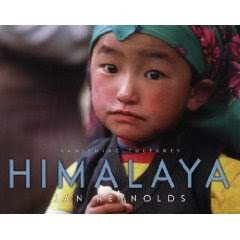 You're the only person alive to have circumnavigated Mount Everest. Why did you choose to go around it, instead of up it?
You're the only person alive to have circumnavigated Mount Everest. Why did you choose to go around it, instead of up it?
We chose to go around Everest because at that time over 100 people had stood on top. Climbing Everest had been done over and over again. Now many 1000's of people have stood on top. But still no one has made it all around Everest at high altitude. It's good to take a new look at an old subject. Climbing around Everest, if you added all the vertical together, would be something like the equivalent of climbing Everest about 4 times. It's harder.....
How do you come up with your ideas and assignments?
My ideas-- they are not difficult to come up with. As in life, your imagination is your only limitation. I just think about where I would like to go, who I would really like to meet, and go from there, putting the pieces together.
How did your new book, CYCLE OF RICE, CYCLE OF LIFE come about?
CYCLE OF RICE came about during a conversation w/ another children's author and scientist, Molly Bang, down at Woods Hole Oceanographic Institute. The conference was to encourage and aid children's authors to write about environmental issues. We thought that Balinese rice farming would be a perfect global example of sustainability by looking at the role of the ducks as natural fertilizers and pesticides, eating bugs, and dropping manure on the fields. So in my usual fashion, I just started putting the pieces together in terms of how to get there, and how to find what I needed to make a book. I found an anthropologist in my research, Steve Lansing, who befriended me and taught me so much, and connected me with the people. I dedicated the book to him, and have a video about him and his work for kids at http://sites.google.com/site/ricefarming/
How long did it take you to gather your research in Bali?
I've been back to Bali a couple of times to put this book and video together. All in all, between working in the field, writing and research, I've put in more time than I can really figure out. Often with children's books it is more a labor of love. If you figured out what you made per hour of work, it would be discouraging!! I look at all my research as entertainment, much better than watching TV. So with this attitude, I can spend as much time as I want on a book. It is my entertainment, and recreation, as well as my work.
 What's the most challenging- the research, the expedition, or the writing?
What's the most challenging- the research, the expedition, or the writing?
Neither the research, nor the expedition, nor the writing is challenging if your attitude is: this is what I do for fun. I love learning things, so research is enriching. Being in the field on an expedition is exciting exploration, and writing is such a joy with a fun editor-- we laugh and poke fun at each other sometimes (I've had the pleasure of some super editors). I believe YOU'LL have to edit this piece! I can't really compare each of these aspects of what I do. They are too different, but each appeals to parts of my personality. As humans, "We are large, we contain multitudes", as Walt Whitman said. It is important to keep discovering yourself and what your abilities are, they are endless, for all of us.
Please visit Jan Reynolds website for more information.
Read BookTalk with Jan Reynolds at Lee & Low's website.
To celebrate Jan Reynolds' blog tour, LeeandLow.com is offering a 26 % discount on CYCLE OF RICE plus free shipping. Just use the discount code JanTour.
 Check out the rest of the CYCLE OF RICE Blog Tour:
Check out the rest of the CYCLE OF RICE Blog Tour:
April 22- Paper Tigers
April 23- A Wrung Sponge
April 27- Carol's Corner
April 30- Lori Calabrese Writes
May 5- Write for a Reader
May 8- Into the Wardrobe
May 14- Bees Knees Reads
Additional Information:
Cycle of Rice, Cycle of Life: A Story of Sustainable Farming
Reading level: Ages 7-12
Hardcover: 48 pages
Publisher: Lee & Low Books (May 2009)
ISBN-10: 1600602541
ISBN-13: 978-1600602542
 Ain't Nothing but a Man: My Quest to Find the Real John Henry
Ain't Nothing but a Man: My Quest to Find the Real John Henry by Scott Reynolds Nelson with Marc Aronson
by Scott Reynolds Nelson with Marc Aronson
Check out more Nonfiction Monday selections at
Picture Book of the Day.
“John Henry told the Captain,
‘A man ain’t nothing but a man,
Before I let your steam drill beat me down,
I’ll die with a hammer in my hand.’”
Was the John Henry of this legendary song a real person? Did he really compete with a steam drill, and did he die doing so?
Ain't Nothing but a Man: My Quest to Find the Real John Henry
is historian Scott Reynolds Nelson’s story about his years-long search to find the answers to these questions and more.
Professor Nelson didn’t start out looking for John Henry. Instead, his initial search was to discover more about the 40,000 or so African-American men who laid railroad tracks throughout the South in the 19th century. There is virtually no information written about them, especially given the fact very few of the workers knew how to write. So, Nelson turned to songs as a means to help him learn more about this important yet missing page in our history. The one song he used as his main piece of evidence was the song about John Henry, a song that would set his research on a more focused path to discovering the real John Henry.
This is a fascinating and gripping book that forbids you to put it down until the very end. What is most captivating is the method in which Nelson presents the information—he’s a detective of the past, using clues to find answers about a person immortalized in a song.
Like any detective, some of his leads turn into dead-ends, but one day as he was sitting at his computer, looking at a scanned postcard that he had seen many times before, he found a clue that would eventually lead him to an amazing and heartbreaking discovery and helped him uncover the secret message the railroad workers worked into John Henry’s song.
The book is scattered with photographs, art, and drawings from the past that paint visuals of the people Nelson spent years searching for, and a section by Marc Aronson in the appendix tells readers, “How to be a Historian.” The appendix also includes information about Professor Nelson’s sources, suggestions for further reading, links to different versions of the song online, and more.
This is a book that I think would interest readers from ages 9 to 99, and it truly shows that history can be fun. Much more than memorizing dates and places and names, history can uncover amazing secrets of the past and take you on different journeys.

This is a must-have in any home, school, or public library, and I’m putting Nelson’s book for adults on the same topic at the top of my must-read list:
Steel Drivin' Man: John Henry, the Untold Story of an American Legend
.
What Other Bloggers are Saying:
BooksForKidsBlog: "Nelson's account is a fascinating detective story which gives young people a different view of history and the work of doing history." (
read more...)
Carol's Corner: "It's a fascinating journey and one that I think kids would absolutely love. " (
read more...)
Bookends: "This is the kind of nonfiction that inspires and motivates and is fun too!" (
read more...)
More info: - Reading level: Ages 9-12
- Hardcover: 64 pages
- Publisher: National Geographic Children's Books (December 26, 2007)
- Language: English
- ISBN-10: 142630000X
- ISBN-13: 978-1426300004
- Source: Review Copy from Publisher


Face to Face With Lions by Beverly and Dereck Joubert. Photographed by Berverly Joubert. National Geographic, 2008 (978-1-4263-0207-7) $16.95
There's a lot that appeals in this new series by National Geographic: plenty of striking photographs of course, an effective design, many interesting extra features. What really worked for me, though, was the use of first person narrative by people who've worked with the animals for a long time. The personal touch makes the information flow and the facts come to life.
Joubert draws us in from the start with an exciting and funny story about how he and his wife Beverley had an encounter with an unfamiliar lion. "We live by an important rule out here. If a lion charges, we stand out ground. If we ran, it would turn into a cat-and-mouse game. And that's a game we couldn't win. So we faced down the angry lion." Joubert is impressed by how perfectly still his wife manages to be, only realizes after the encounter is over that she had very sensibly backed slowly away.
Following this, we learn about the areas where lions live, about the course of their lives, and about the issues that threaten them. Personal information keeps the narrative lively: "We love to watch lions with cubs. Sometimes you'll see the cubs running, leaping, biting an ear, attacking a tail. The cubs in a pride are usually born around the same time. They suckle the milk from any mother they come across any time. After three of four months, I doubt whether the mothers even know which cubs are theirs." Throughout the book the photographs, all labeled with extra detail, are exciting and eye-catching, ranging from the aggressive grandeur of the pack leaders to the cuteness of the cubs. There's a bit of realistic gore, as this is a book about predators, but I think only very sensitive children would find it too much.
Extra features at the end of the book include a section on how to help endangered creatures, suggestions for observing lions in a zoo, a round-up of general facts, a glossary, books and websites, and an index. Even the research and photographic notes have a personal touch, describing sitting in 128 degree temperatures for 12 hours straight, only to lose a perfect shot to a dead battery.
This is an excellent choice for school and public libraries and might even be able to turn on kids who aren't usually attracted to nonfiction. (6-9)
Find more excellent nonfiction at the Nonfiction Monday Round Up.
 Pompeii: Unearthing Ancient Worlds by Liz Sonneborn
Pompeii: Unearthing Ancient Worlds by Liz Sonneborn
Reading level: Ages 9-12
Library Binding: 80 pages
Publisher: Twenty-First Century Books (CT) (December 15, 2007)
ISBN-10: 0822575051
ISBN-13: 978-0822575054
Source: Review copy from publisher
This week's nonfiction selection is part of the new "Unearthing Ancient Worlds" series.
In 79 A.D. Mt. Vesuvius erupted destroying three cities in the Ancient Roman Empire: Naples, Herculaneum, and the most famous of the three, Pompeii.
In 1738, a farmer was digging a well near the town of Resina and dug up marble objects from the ground. Charles of Bourbon, the son of the king of Spain, heard of these finds and sent a member of his army, Joachin de Alcubierre to Resina to find out more about these objects. Pompeii: Unearthing Ancient Worlds details Alcubierre's discovery and excavation of Herculaneum and later of Pompeii.
Through full-color photographs and a detailed and engaging narrative, the book describes many of the treasures that were found as well as the things that went wrong with the excavation under Alcubierre's command. His lack of knowledge of proper excavation techniques, unfamiliarity with art, and desire to win favor with the king resulted in a rushed job, hazardous working conditions, and overlooked artifacts. After decades of backbreaking work and various setbacks, Alcubierre and his crew managed to unearth an abundance of priceless artifacts.
Readers can see many of the treasures that were unearthed, including beautiful frescoes, marble statues, mosaic floors, paved streets, and public fountains. Maps, a time line, a pronunciation guide, a glossary, and a "Who's Who" section in the back of the book add to the richness of the narrative and give readers a wealth of information about these ancient cities buried under the ash. There's even a list of books and online resources where readers can go to find more information.
This would make an excellent resource for lessons about Ancient Rome, archeology, Pompeii, art, volcanic eruptions, and more. Kids who are interested in any of these subjects will find the content easily digestible and the photos and illustrations interesting.
I'm eager to read the other books in the series:
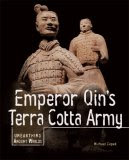 Emperor Qin's Terra Cotta Army by Michael Capek
Emperor Qin's Terra Cotta Army by Michael Capek
From the publisher: "A dead emperor guarded by his army for 2,000 years… One day in 1974, a group of farmers in rural China found a life-size clay statue of a man’s head buried deep in a field. When government archaeologists inspected the area, they discovered that beneath the ground were more than eight thousand life-size clay soldiers, each one with a unique face. In nearby chambers, they unearthed clay horses, carefully preserved swords, bronze statues, and other astonishing things." (Read more...)
 Palenque by Deborah Kops
Palenque by Deborah Kops
From the publisher: "Mysterious ancient ruins, hidden deep in the jungle of southern Mexico… In May 1840, explorers John Stephens and Frederick Catherwood road their mules along a steep, muddy jungle path. They were hoping to find the ruins of an ancient, deserted site in Mexico they knew only from visitors’ accounts. Through the trees, they spied the remains of a crumbling stone palace. Palenque!" (read more...)
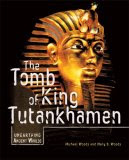 The Tomb of King Tutankhamen by Michael Woods and Mary B. Woods
The Tomb of King Tutankhamen by Michael Woods and Mary B. Woods
From the publisher: "A royal treasure buried for 3,000 years … On November 4, 1922, a British archaeologist named Howard Carter unearthed a buried staircase in Egypt’s Valley of the Kings. At the bottom of the staircase was a door bearing the name Tutankhamen..." (read more...)
What Other Bloggers are Saying:
A Patchwork of Books: (on the series) "These are great books for visual learning, as well as text reading. They are written in a very flowing manner, rather than dry like a lot of non-fiction books, and read almost like a story. The photographs and paintings depicted in the books are amazing and the huge amount of facts offered is astounding." (read more...)
If you've reviewed any books in the Unearthing Ancient Worlds Series, leave a comment with the link, and I'll post it here.
.jpg?picon=380)
By:
Just One More Book!!,
on 11/13/2007
Blog:
Just One More Book Children's Book Podcast
(
Login to Add to MyJacketFlap)
JacketFlap tags:
Bullying/Abuse,
Health & Safety,
Father/Daughter,
Jaime Zollars,
Not in Room 204,
sexual abuse,
Shannon Riggs,
review,
Podcast,
Community,
Ages 4-8,
Detailed,
Formal,
Compassion,
Courage,
Picture book,
Girl,
Making a difference,
Resilience,
childrens book,
Fun,
Hope,
Humour,
Cute,
Assertiveness,
Confidence,
Mischief,
Harmony,
Manners,
Understanding/Tolerance,
Communication,
Health & Safety,
Father/Daughter,
Bullying/Abuse,
Jaime Zollars,
Not in Room 204,
sexual abuse,
Shannon Riggs,
Add a tag
 Author: Shannon Riggs
Author: Shannon Riggs
Illustrator: Jaime Zollars
Published: 2007 Albert Whitman & Co. (on JOMB)
ISBN: 0807557641 Chapters.ca Amazon.com
Classroom shenanigans, expressive illustrations and the delicate weaving of carefully chosen details make this important story a haunting yet hopeful nudge toward breaking the silence of sexual abuse.
Shannon Rigg has supplied the following resources to help start making noise about sexual abuse:
Tags:
childrens book,
Jaime Zollars,
Not in Room 204,
Podcast,
review,
sexual abuse,
Shannon Riggschildrens book,
Jaime Zollars,
Not in Room 204,
Podcast,
review,
sexual abuse,
Shannon Riggs
 I peer into the darkness and at long last I see the light at the end of the tunnel. We’re almost there! Almost at the end of this month’s 31 Days, 31 Lists challenge. I’m certainly delighted, not least because I’ve managed to keep it up so far (knocking on wood now as hard as my brittle knuckles can knock).
I peer into the darkness and at long last I see the light at the end of the tunnel. We’re almost there! Almost at the end of this month’s 31 Days, 31 Lists challenge. I’m certainly delighted, not least because I’ve managed to keep it up so far (knocking on wood now as hard as my brittle knuckles can knock).























































 0 Comments on Just the books you need to tackle middle school as of 1/1/1900
0 Comments on Just the books you need to tackle middle school as of 1/1/1900






















 Author:
Author:
I choose to focus on what you have accomplished this month. I’m grateful for every title and cover you have featured. Today’s list might not be the most extensive, but the quality of those books you did read and shared with us is exceptional. I anticipated that this daily gift from you would be phenomenal, based on the quality of your daily posts. However, you have exceeded any and all my expectations several times over. What fun it has been to look forward to a new list every day this month. Thank you so very much.
Aw. Thank you. That alone makes all this worth it.